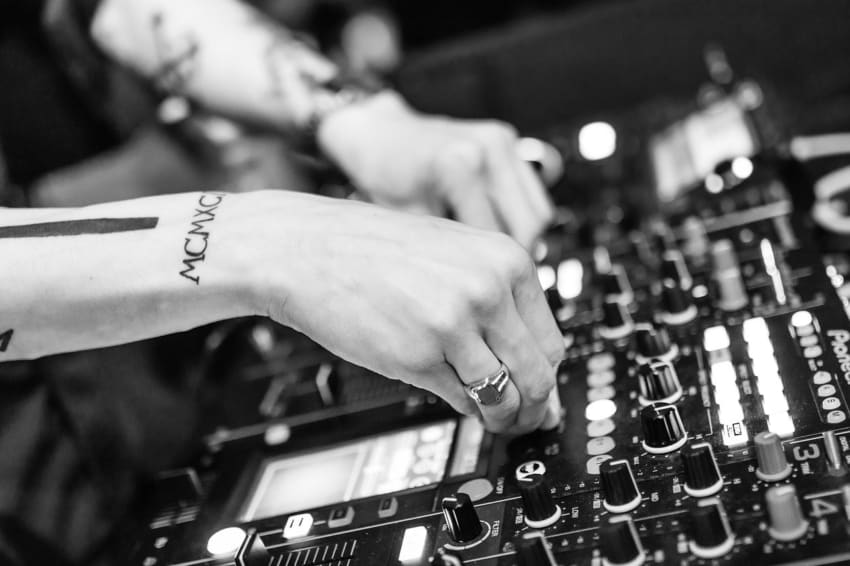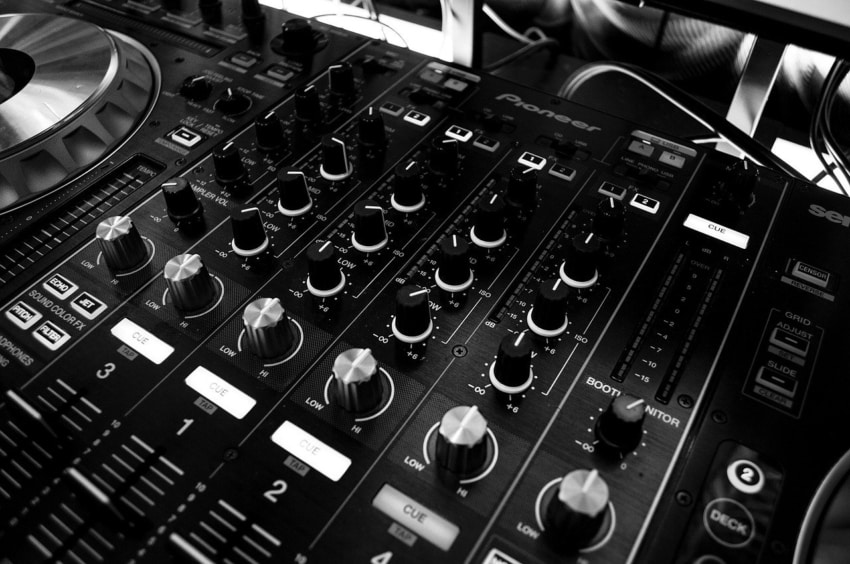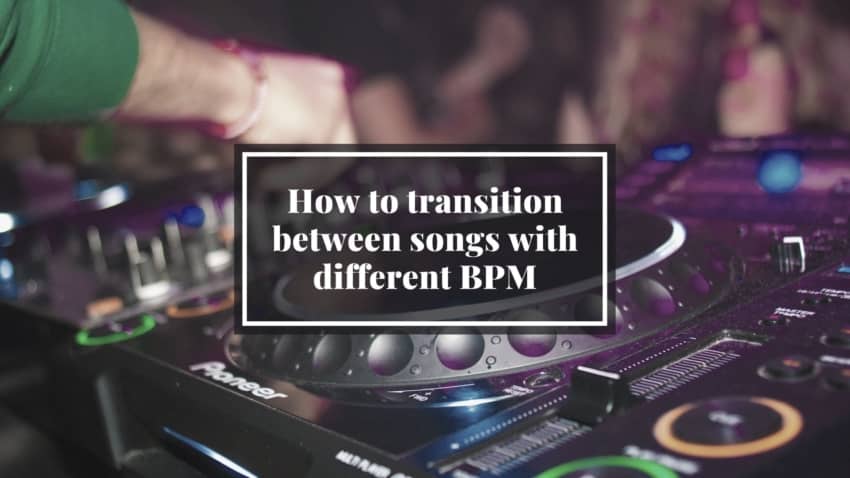Mixing songs with a variety of tempos is a necessity for any modern-day DJ.
Experienced or not, mixing songs of different BPM requires skill and the technology that gives you with the tools to do so.
Sometimes you’ll want to make a drastic switch, let’s say from 150 to 80 BPM, right?
Many DJs will simply select a playlist that uses the same BPM throughout; most house music is played at 128 with a variation from between 123 and 130, which makes things easier.
However, Drum and Bass averages 160, and dubstep 140.
Hip hop songs vary in range from around 95 to 105.
So, if you have a varied playlist, you need to learn how to change BPM drastically without breaking the mood on the dance floor.
Other related articles that you might find useful:
Why Play at Different Tempos?
Changes in tempo can be subtle or extreme; extreme changes often go unnoticed on the dance floor. It is however essential to play tracks at the BPM it was intended for:
- The energy of a track is not related directly to its BPM. A track with a low BPM can be full of energy, and it can be as danceable as the next. Limiting your playlist to only songs of one tempo will severely limit your set.
- All tracks on your playlist were recorded at a tempo; they were also intended to be played at the same tempo.
- When you learn to alter BPMs throughout your track list you become a better DJ. Djing is not just about beat matching; it’s also about being able to move around tempo ranges easily.
- The crowd will love you when you change tempo correctly. A well-executed tempo can give the crowd time to recover energy and breathe, adding excitement and anticipation for the next song or genre you will be playing.
So, let’s get straight into how to do this properly:
How to transition between songs with different BPM

Here I will teach you the basic techniques that you can use in order to transition properly between songs that have different BPM.
Cut Slam Technique
The cut slam technique for changing tempos involves the quick stop of sound on deck A and replacing it with the sound from deck B.
This is known in the trade as Cross-fader shifted quickly (slam), and is known as Hip Hop Slam by some.
It is not that difficult to master and simply involves the shifting of the cross-fader quickly to another deck.
The result is that the sound from deck one is muted and gone and the sound coming from deck 2 is instantly heard.
It’s used commonly by Hip Hop DJ’s as hip-hop music, unlike house, has a lot of BPM variations that cannot always be fitted together easily.
The cut slam technique for changing tempos is however far from easy.
It’s not just about cutting off the sound from one deck and replacing it with sound from the next, it requires experience and experimenting, in order to memorize which songs can be cut out and at which part to do so.
It is also best to do the cut in a section that doesn’t have any beat so that it is much less likely to crash.
To become a master of cut slam, you need to recognize the structure of EDM songs.
This means understanding where there is a breakdown, and where the intro, build up, outro, and peaks 1 and 2 are.
If you want to cut/ slam like a professional, you should always try to do so on breakdown; this is your safest bet and as we said before, will prevent train-wreck.
Once you are confident with the basic cut/slam technique, you can also try combining it with some simple scratching, or alternatively with sample triggers like a rewind sound or the popular horn sound that we often hear when on the dance floor.
The cut/slam is the easiest way to change BPMs on the dance floor, but it’s also the most dangerous.
Get it wrong, and your crowd will not be impressed!
Delay Freeze
Delay freeze, also known as tractor, was popularized by Ean Golden.
The way delay freeze works is by letting the first track stop with a continuous delay, then stopping the track and running the track to two.
In doing so, the first delay tempo will produce a smooth transition as it will automatically follow the second track tempo.
To It’s not that difficult to use delay freeze.
When the first track you are playing is going to be stopped, you activate the effect and run the second track, then stop the first.
The result is that part of the first song you play will sound like echo following the 2nd song.
The technique is not too hard to master, and is an effective way of transitioning songs with different BPMs without having to cut or slam.
Using a BPM Transition Track

If you are looking for the safest way to change tempos between songs on your playlist, using a BPM transition track is probably the easiest and safest way to do so.
It’s the safest way to dramatically change tempo, once you have mastered the manual beat-matching process.
If you know how to create remixed music, and are confident in doing so, you can create remixes that start with one BPM and end with a different one.
You can even find transitional songs that will do the whole process for you, on some DJ websites.
You can pick up songs that change tempo from say 128 to 100.
As house songs generally have a BPM of 123 to 130 and hip hop 100, this is an excellent way to mix up your set and deliver not just hip hop or house, but both to your audience.
One point that you need to note when selecting transitional songs is that you will need to use your own ear to decipher the BPM.
You cannot use DJ software for the process since such software will only detect one BPM in a song, and would in this case detect either 128 or 100, but not both.
Beat-matching with your own ears is therefore essential and of course more natural than using software for the process.
Tempo Fader and Double/Divide Tempo
Another technique that can be used to transition from one tempo to the next is to use a tempo fader in combination with the double/divide feature.
As you are already aware, each controller will have a tempo fader with a range that you can set.
So, let’s take an example of a transition from 155 to 85. To perform this successfully, you would have to:
- Make sure that the synch button is currently in the off position, and raise the tempo of the first track from 155 to 160 BPM, using the tempo fader
- Press “/2” in order for the BPM to change and to read 80 BPM
- Use the tempo fader to raise the BPM to 85
- Enable the sync buttons to run track to number two.
Using this technique, we can start off with a song with 100BPM, raising it slowly up through 128 to 130, 140, and 155.
We then go on to divide by two, starting over from 75, and then going back to 100.
When you master this trick, you will be able to reach all the different BPM ranges smoothly.
Changing Tempo Gradually Throughout a Song to Match the Next
This technique is quite easy to master, and requires two songs sharing a small difference in tempo.
Let’s say you wish to switch from 130 to 120 BPM; A gradual change in tempo means that the two songs will share the change, that will be just 5 BPM, and both songs will be played at 125 at the end, which is just 5 BPM lower than they were originally recorded for.
This technique can be used consistently during your set, but is only ideal for small to medium beat ranges.
Keylock
Keylock on the other hand can be used to flip from high to low tempos or indeed from any range to the next.
Let’s say you are currently playing a 115 BPM house song and you want to switch to an 85 BPM hip hop song next.
During the last chorus of your first song, you would slow down the tempo to 85 over a period of around 10 seconds, key-locking it to ensure the pitch stays the same.
As soon as the chorus is finished, beat-match the hip-hop tune in.
This method does risk the first track sounding a bit ropey, but the transition will take 10 seconds, and the crowd will be concentrating on the tempo change and not the quality of the sound for those ten seconds.
Half/ Double Speed Trick
If you are looking for an extreme way to mix and change from a high BPM to a low one, or vice versa, the double/half speed trick could be for you.
It’s an extreme mix however that is probably better used in lounges and bars than on the dance floor.
The reason for this is quite clear; unless you can do this extremely well, you are likely to clear the dance floor due to the drastic change in beat from this technique.
The basic technique involves taking a high BPM track such as a 156 drum and bass track, and mixing it into a chill-out tune that will have half the BPM (78 in this case).
The technique can be used either from fast to slow, or indeed, the other way round.
Mixing in a Percussion Loop

Mixing in a percussion loop involves mixing into a loop, speeding up or down the loop to the required tempo, and then mixing in your next tune.
With this technique uses, and the advanced version of key-lock to latter the tempo, you will have a distinctive key-locked percussion loop.
This could include tom toms or bongos, or whatever you want to include that fits with the songs you are transitioning between.
Once you are only playing the percussion loop at the end of the first tune, you change the tempo of the loop, and finish by mixing in the second tune.
How to become a better DJ?
We all know that in order to become a better DJ we need to practice, right?
But we also need to practice the right way and learn what is really going to help us improve in the long run, since practicing the wrong way will get us nowhere.
This is where learning from seasoned DJs can actually help, and nowadays one of the best places to learn is the internet.
Which is why I wrote a post about the best Online DJ schools & courses currently available that you should definitely check out.
The ones I’d recommend the most are from DJ Courses Online since they offer great quality courses at an affordable price, especially since it’s subscription-based, which means that you can pay for a single month and do all the courses you want.
If you even want to get more bang for your buck, getting the yearly subscription will save you a total 50%.
Conclusion
Follow these steps and practice all these techniques, at first on your own before moving to a large venue, and you will get much better.
Just remember that it takes time and hard work!
I hope this information was useful!
Have a wonderful day!
